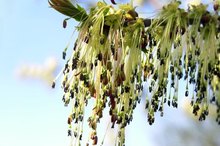What Do IGE Class Levels Mean?
IgE class levels provide an indication of the severity of a suspected allergy. For a patient exhibiting symptoms of an allergic reaction, two types of blood allergy tests exist: the radioallergosorbent, or RAST, and the IgE antibody or enzyme-linked immunosorbent assay test, also known as ELISA. Different from allergy skin tests, these blood tests help decipher the levels of antibodies present in the blood when subjected to an allergen. Understanding levels of IgE facilitates diagnosis and treatment.
If you are experiencing serious medical symptoms, seek emergency treatment immediately.
Class Levels
According to Marshfield Labs, class levels serve as a reference to determine the required level of treatment, and are standard among most testing laboratories 1. A class level of 0 is considered a negative reading, while level 1 means an equivocal or unclear reading. Class levels of 2 and 3 are deemed positive readings, but levels 4, 5 and 6 rank as strongly positive.
Results
A High Number of Leukocytes
Learn More
Different levels of IgE can assist in determining which allergen caused the allergic reaction. In the reference book "Mosby's Manual of Diagnostic and Laboratory Tests," registered nurse Kathleen D. Pagana and Dr. Timothy J. Pagana explain that a patient has been exposed to a particular allergen before skin testing, a blood test may provide more accurate results than a skin test 2.
Inaccurate Readings
Based upon the type of allergen, the accuracy rates for blood-based allergy tests range between 45 percent and 95 percent, according to the Paganas. Even if an individual tested more than once shows a continued higher level of a particular antibody, that does not necessarily indicate a high level of reaction to a specific allergen. In some cases, individuals known to have higher class levels of IgE in their system exhibit no symptoms at all when exposed to the allergen.
- Based upon the type of allergen, the accuracy rates for blood-based allergy tests range between 45 percent and 95 percent, according to the Paganas.
- In some cases, individuals known to have higher class levels of IgE in their system exhibit no symptoms at all when exposed to the allergen.
Treatment
Normal IgE Levels
Learn More
After the IgE class has been determined, class levels help the physician and patient choose appropriate treatment options. For instance, with an IgE level in the low range, the patient may be able to avoid certain allergens, such as cat dander. If the IgE level appears high, however, the necessary protocols for immunotherapy -- such as allergy shots -- may be required.
Related Articles
References
- Marshfield Labs: Test Directory
- "Mosby's Manual of Diagnostic and Laboratory Tests"; , Kathleen D. Pagana and Timothy J. Pagana; 2009
- Asthma and Allergy Foundation of American. Allergy diagnosis. Updated October 2015.
- American College of Allergy, Asthma, & Immunology. Allergy testing.
- American College of Allergy, Asthma, & Immunology. Skin test. Updated April 16, 2018.
- Birch K, Pearson-Shaver AL. Allergy testing. In: StatPearls. Updated February 16, 2019.
- Portnoy, JM. Appropriate allergy testing and interpretation. Missouri medicine. 2011;108(5):339-43.
- U.S. National Library of Medicine. Allergy blood test.
- Cleveland Clinic. Do you have allergies? How testing works. Updated June 8, 2018.
- American College of Allergy, Asthma, & Immunology. Allergy testing in children and infants.
- WHO Best Practices for Injections and Related Procedures Toolkit. Best practice in phlebotomy and blood collection. Updated March 3, 2010.
- Kowalski ML, Ansotegui I, Aberer W, et al. Risk and safety requirements for diagnostic and therapeutic procedures in allergology: World Allergy Organization statement. World Allergy Organization Journal. 2016;9(1):33. doi:10.1186/s40413-016-0122-3
Writer Bio
Heather Earley has written on a variety of subjects centered around rare disease. She is a published author for the MAGIC Foundation, a writer for the Children's Rare Disease Network, and content director and writer for the Global Genes Project blog. Earley has worked in the health-care industry for more than 20 years.








